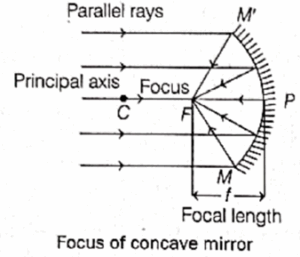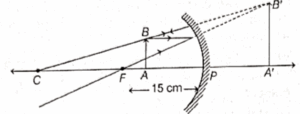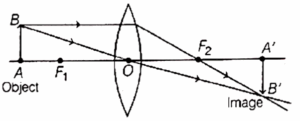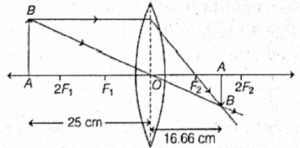Light – Reflection and Refraction
NCERT--CBSE-Class-10-Science-Chapter-9
Solutions
In−text Solutions (Page 142)
Question 1: Define the principal focus of a concave mirror.
It is a point on the principal axis at which a beam of light incident parallel to the principal axis converges after reflection from the concave mirror.

Question 2: The radius of curvature of a spherical mirror is 20 cm. What is its focal length?
Focal length = \(\frac{1}{2}\) x Radius of curvature = \(\frac{1}{2}\) x 20 = 10 cm
Question 3: Name a mirror that can give an erect and enlarged image of an object.
Concave mirror.
Question 4: Why do we prefer a convex mirror as a rear-view mirror in vehicles?
The field of view of a convex mirror is wider than that of concave mirror and convex mirror always produces erect image of object, so we prefer convex mirror as rear view mirror for vehicles.
In−text Solutions (Page 145)
Question 1: Find the focal length of a convex mirror whose radius of curvature is 32 cm.
Given, radius of curvature, R = 32 cm
As we know, focal length, f = \(\frac{\text{radius of curvature}}{2}\) = 16 cm
Question 2: A concave mirror produces three times magnified (enlarged) real image of an object placed at 10 cm in front of it. Where is the image located?
As the image is real, so magnification m must be negative.
m = \(\frac{h'}{h}=-\frac{v}{u}\) = -3
∴ v = 3 u
Given u = - 10 cm
∴ u = 3 x (- 10) = - 30 cm.
Thus the image is located at a distance of 30 cm from the mirror on the object side of the mirror.
In−text Solutions (Page 150)
Question 1: A ray of light travelling in air enters obliquely into water. Does the light ray bend towards the normal or away from the normal? Why?
Light bends towards the normal on entering water. It happens because water is an optically denser medium than air. When light travels from a rarer medium to denser medium, it bends towards the normal.
Question 2: Light enters from air to glass having refractive index 1.50. What is the speed of light in glass? The speed of light in vacuum is 3 x 108 ms-1.
Refractive index of glass, ng = 1.50
Speed of light in vacuum, c = 3 x 108 ms-1
Speed of light in glass = \(\frac{c}{n_g}\) = \(\frac{3×10^8}{1.5}\) = 2 x 108 ms-1
Question 3: Find out from table given below, the medium having highest optical density. Also, find the medium with the lowest optical density.
Absolute Refractive Index of Some Material Media
| Material Medium | Refractive Index | Material Medium | Refractive Index |
| Air | 1.0003 | Crown glass | 1.52 |
| Ice | 1.31 | Canada Balsam | 1.53 |
| Water | 1.33 | Rock salt | 1.54 |
| Alcohol | 1.36 | Carbon disulphide | 1.63 |
| Kerosene | 1.44 | Dense flint glass | 1.65 |
| Fused quartz | 1.46 | Ruby | 1.71 |
| Turpentine oil | 1.47 | Sapphire | 1.77 |
| Benzene | 1.50 | Diamond | 2.42 |
From Table,
- Diamond has highest refractive index (= 2.42), so it has largest optical density.
- Air has lowest refractive index (= 1.0003), so it has lowest optical density.
Question 4: You are given kerosene, turpentine and water. In which of these does the light travel fastest? Use the information given in above Q.3. Table
For kerosene, n = 1.44
For turpentine oil, n = 1.47
For water, n = 1.33
As water has lowest refractive index, so light travels fastest in this optically rarer medium than kerosene and turpentine oil.
Question 5: The refractive index of diamond is 2.42. What is the meaning of this statement?
Refractive index of any medium w.r.t. another indicates the extent to which light bends, when it enters from first medium to the given medium.
The given value of refractive index also states that speed of light in diamond is 1/2.42 times to the speed of light in vacuum.
In−text Solutions (Page 158)
Question 1: Define 1D of power of lens.
One dioptre is the SI unit of power of lens, whose focal length is 1 m.
Question 2: A convex lens forms a real and inverted image of a needle at a distance of 50 cm from it. Where is the needle placed in front of the convex lens if the image is equal to the size of the object? Also, find the power of the lens.
Here, v = +50 cm, ….[v is positive for real image]
As the real image is of the same size as the object, so
m = \(\frac{h'}{h}=-\frac{v}{u}\) = -1
∴ u = - v = - 50 cm.
Now \(\frac{1}{f}=\frac{1}{v}-\frac{1}{u}\) = \(\frac{1}{50}-\frac{1}{-50}\) = \(\frac{1}{50}+\frac{1}{50}\) = \(\frac{2}{50}=\frac{1}{25}\)
∴ f = 25 cm = 0.25 m
P = \(\frac{1}{f}\) = \(\frac{1}{0.25}\) = +4 D
Question 3: Find the power of a concave lens of focal length 2 m.
As the focal length of a concave lens is negative, so f = -2 m
P = \(\frac{1}{f}\) = \(\frac{1}{2}\) = -0.5 D
Exercise Solutions
Question 1. Which one of the following materials cannot be used to make a lens?
(a) Water (b) Glass (c) Plastic (d) Clay
(d) Clay
Clay can never be transparent, so it cannot be used to make lens.
Question 2. The image formed by a concave mirror is observed to be virtual, erect and larger
than the object. Where should be the position of the object?
(a) Between the principal focus and the centre of curvature
(b) At the centre of curvature
(c) Beyond the centre of curvature
(d) Between the pole of the mirror and its principal focus.
(d) Between the pole of the mirror and its principal focus.
If the object is placed between pole of the mirror and its principal focus virtual, erect and magnified image will be formed.
Question 3. Where should an object be placed in front of a convex lens to get a real image of the size of the object?
(a) At the principal focus of the lens
(b) At twice the focal length
(c) At infinity
(d) Between the optical centre of the lens and its principal focus.
(b) At twice the focal length
To get the real image of the size of the object, it should be placed at twice the focal length of a convex lens.
Question 4. A spherical mirror and a thin spherical lens have each a focal length of –15 cm. The mirror and the lens are likely to be
(a) both concave.
(b) both convex.
(c) the mirror is concave and the lens is convex.
(d) the mirror is convex, but the lens is concave.
(a) both concave.
The focal length is taken as negative for both concave mirror and concave lens.
Question 5. No matter how far you stand from a mirror, your image appears erect. The mirror
is likely to be
(a) only plane.
(b) only concave.
(c) only convex.
(d) either plane or convex.
(d) either plane or convex.
Plane mirrors and convex mirrors always form the erect images.
Question 6. Which of the following lenses would you prefer to use while reading small letters found in a dictionary?
(a) A convex lens of focal length 50 cm.
(b) A concave lens of focal length 50 cm.
(c) A convex lens of focal length 5 cm.
(d) A concave lens of focal length 5 cm.
(c) A convex lens of focal length 5 cm.
Convex lens is used as magnifying glass.
As, focal length, f = \(\frac{1}{P}\)
Convex lens of focal length 50 cm has power 2 D,
whereas convex lens of focal length 5 cm has power 20 D.
Hence for, better performance its focal length should be small.
Question 7. We wish to obtain an erect image of an object, using a concave mirror of focal length 15 cm.
What should be the range of distance of the object from the mirror?
What is the nature of the image?
Is the image larger or smaller than the object?
Draw a ray diagram to show the image formation in this case.
The object should be kept at a distance less than 15 cm from the mirror.
The image is virtual and erect.
The image is larger than the object.

Question 8. Name the type of mirror used in the following situations.
(a) Headlights of a car.
(b) Side/rear-view mirror of a vehicle.
(c) Solar furnace.
Support your answer with reason.
(a) Concave mirror to get powerful beam of light.
(b) Convex mirror to get larger field of view and erect image.
(c) Concave mirror, as it can converge light rays of the sun on a small area.
Question 9. One-half of a convex lens is covered with a black paper. Will this lens produce a complete image of the object? Verify your answer experimentally. Explain your observations.
The lens will produce a complete image, but the image will have lower intensity and brightness because in the lower part of the lens the rays are blocked.

Question 10. An object 5 cm in length is held 25 cm away from a converging lens of focal length 10 cm. Draw the ray diagram and find the position, size and the nature of the image formed.

Given, object size, ho =5 cm; Image size, hi =?
Object distance, u = - 25 cm; Image distance, v =?
Focal length, f = 10 cm
From lens formula, \(\frac{1}{f}=\frac{1}{v}-\frac{1}{u}\)
Or \(\frac{1}{v}=\frac{1}{f}+\frac{1}{u}\) = \(\frac{1}{10}+\frac{1}{-25}\) = \(\frac{3}{50}\)
Or v = \(\frac{50}{3}\) = 16.67 cm from the lens
Size of image,
ho = hi x \(\frac{v}{u}\) = 5 x \(\frac{50}{3×(-25)}\) = - 3.33 cm
The image is real in nature.
Question 11. A concave lens of focal length 15 cm forms an image 10 cm from the lens. How far is the object placed from the lens? Draw the ray diagram.
Given, focal length, f = - 15 cm
Image distance, v = - 10 cm
By lens formula, \(\frac{1}{f}=\frac{1}{v}-\frac{1}{u}\)
∴ \(\frac{1}{u}=\frac{1}{v}-\frac{1}{f}\) = \(\frac{1}{-10}-\frac{1}{-15}\) = \(-\frac{1}{30}\)
u = - 30 cm from the lens.
Thus, the object is placed at 30 cm from the concave lens.
Question 12. An object is placed at a distance of 10 cm from a convex mirror of focal length 15 cm. Find the position and nature of the image.
Given, object distance, u = - 10 cm
Focal length, f = 15 cm
By mirror formula, \(\frac{1}{v}=\frac{1}{f}-\frac{1}{u}\) = \(\frac{1}{15}-\frac{1}{-10}\) = \(\frac{5}{30}\) = \(\frac{1}{6}\)
v = 6 cm from the mirror
Image is formed 6 cm behind the mirror.
So, image is virtual and erect.
Question 13. The magnification produced by a plane mirror is +1. What does this mean?
If magnification is 1, the image size is same as that of object size.
Since, magnification is positive, the image is erect and virtual.
Question 14. An object 5.0 cm in length is placed at a distance of 20 cm in front of a convex mirror of radius of curvature 30 cm. Find the position of the image, its nature and size.
Given : object size, ho = 5 cm, Object distance, u = - 20 cm,
Radius of curvature = 30 cm
Focal length, f = \(\frac{30}{2}\) = 15 cm
Position of image (by mirror formula)
\(\frac{1}{f}=\frac{1}{v}+\frac{1}{u}\) or \(\frac{1}{v}=\frac{1}{f}-\frac{1}{u}\) = \(\frac{1}{15}-\frac{1}{-20}\) = \(\frac{7}{60}\)
v = \(\frac{60}{7}\) = 8.57 cm
Image is formed at 8.57 cm behind the mirror.
∴ Magnification, m = \(\frac{h_i}{h_o}\) = \(-\frac{v}{u}\)
= \(-\frac{60}{-20×7}\) = \(\frac{h_i}{5}\)
∴ hi = \(-\frac{5×60}{-20×7}\) = 2.14 cm
Image is diminished, erect and hence virtual.
Question 15. An object of size 7.0 cm is placed at 27 cm in front of a concave mirror of focal length 18 cm. At what distance from the mirror should a screen be placed, so that a sharp focused image can be obtained? Find the size and the nature of the image.
Given: object size, h0 = 7 cm, Object distance, u = - 27 cm
Focal length, f = - 18 cm
By mirror formula, \(\frac{1}{v}=\frac{1}{f}-\frac{1}{u}\) = \(\frac{1}{-18}-\frac{1}{-27}\) = \(-\frac{1}{54}\)
Screen should be placed at 54 cm in front of the mirror.
Now, \(\frac{h_i}{h_o}\) = \(-\frac{v}{u}\)
\(\frac{h_i}{7}\) = \(-\frac{-54}{-27}\) = -2
hi = 7 x -2 = -14 cm
So, image is double the size of object. Also, image is real and inverted (since, hi is negative).
Question 16. Find the focal length of a lens of power – 2.0 D. What type of lens is this?
Focal length, f = \(\frac{1}{Power}\) = \(\frac{1}{-2}\) - 0.5 m
Since, f is negative, lens is concave.
Question 17. A doctor has prescribed a corrective lens of power +1.5 D. Find the focal length of the lens. Is the prescribed lens diverging or converging?
Given : power of lens, P = +1.5 D
It means the lens is convex
As power, P = \(\frac{1}{f(in\,m)}\)
f = \(\frac{1}{P}\) = \(\frac{1}{+1.5}\) = 0.66 m
f = 0.66 × 100 = 66 cm
[It is a converging lens because its focal length is positive.]
Click on below links to get PDF from store
PDF : Class 10th-Science-Chapter-9-Light – Reflection and Refraction-Notes
PDF : Class 10th-Science-Chapter-9-Light – Reflection and Refraction-Solution
All Chapters Class-10-Science-NCERT- Notes set (13-PDF) Rs.73
All Chapters Class-10-Science NCERT-Solution set (13-PDF) Rs.55
All Chapters Class-10-Science-NCERT- Notes & Solutions set (26-PDF) Rs.105
Main Page : NCERT-Class-10-Science – All chapters notes, solutions, videos, test, pdf.
Previous Chapter : Chapter 8: Heredity – Online Notes
Next Chapter : Chapter-10-Human Eye and Colourful World – Online Notes
